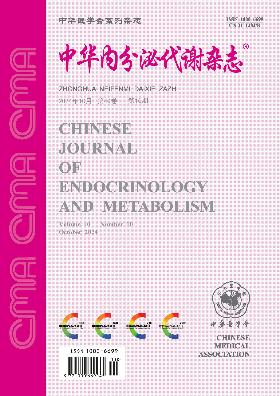Study on insulin resistance, glycolipid metabolism, and sex hormones in patients with polycystic ovary syndrome
Q4 Medicine
引用次数: 0
Abstract
Objective To evaluate the insulin resistance of patients with polycystic ovary syndrome (PCOS) by hyperinsulin-euglycemic clamp test, and to explore the characteristics of glycolipid metabolism and sex hormone levels in PCOS patients with insulin resistance. Methods Seventy-three patients with PCOS and 27 healthy women with body mass index and age matched with PCOS patients who were admitted to the Department of Endocrinology of Affiliated Hospital of Zunyi Medical University from July 2017 to February 2019 were underwent hyperinsulin-euglycemic clamp test. All subjects were grouped according to glucose metabolic rate, body mass index, and homeostasis model assessment for insulin resistance (HOMA-IR), the changes and differences of glucose and lipid metabolism and sex hormone indexes in PCOS patients were analyzed. Results In the PCOS group, impaired glucose regulation accounted for 3.23% (1/31), and abnormal lipid metabolism for 9.68% (3/31). In the PCOS with insulin resistance group, impaired glucose regulation accounted for 7.14% (3/42). Abnormal blood lipid metabolism reached 47.62% (20/42), and 5 patients were diagnosed with metabolic syndrome, accounting for 11.90%. Correlation analysis showed glucose metabolic rate and body mass index, waist-to-hip ratio, systolic blood pressure, fasting plasma glucose, fasting insulin, HOMA-IR, cortisol, triglyceride, total cholesterol, low density lipoprotein-cholesterol (LDL-C), free androgen index (FAI), and glutamyl transpeptidase (GGT) were negatively correlated(all P<0.05), while positively correlated with high density lipoprotein-cholesterol (HDL-C; P=0.028). HOMA-IR was positively correlated with body mass index, waist-to-hip ratio, systolic blood pressure, fasting plasma glucose, fasting insulin, HbA1C, LDL-C (P<0.05), and negatively correlated with glucose metabolic rate and HDL-C (P<0.05). Body mass index and waist-to-hip ratio, systolic blood pressure, fasting plasma glucose, fasting insulin, HOMA-IR, triglyceride, and LDL-C (P<0.05) were positively correlated, and negatively correlated with glucose metabolic rate, HDL-C, and sex hormone binding globulin (SHBG; P<0.01). Multivariate linear stepwise regression analysis showed that body mass index, total cholesterol, triglyceride, and cortisol were principal factors affecting glucose metabolic rate. Fasting plasma glucose, fasting insulin, and systolic blood pressure were important factors influencing HOMA-IR. Glucose metabolic rate, HOMA-IR, HDL-C, while SHBG were still vital to body mass index. Conclusion FAI, SHBG, and cortisol may be involved in the insulin resistance development of PCOS patients, and PCOS patients with insulin resistance were more susceptible to metabolic disorders. Key words: Polycysic ovarian syndrome; Insulin resistance; Hyperinsulin-euglycemic clamp; Glycolipid metabolism; Sex hormone多囊卵巢综合征患者胰岛素抵抗、糖脂代谢及性激素的研究
目的应用高胰岛素-正糖钳试验评价多囊卵巢综合征(PCOS)患者的胰岛素抵抗,探讨多囊卵巢综合征合并胰岛素抵抗患者糖脂代谢及性激素水平的变化特点。方法2017年7月至2019年2月在遵义医科大学附属医院内分泌科就诊的73例PCOS患者和27例体重指数、年龄与PCOS患者匹配的健康女性进行高胰岛素-血糖钳夹试验。根据糖代谢率、体重指数、胰岛素抵抗稳态模型评估(HOMA-IR)对所有受试者进行分组,分析PCOS患者糖脂代谢及性激素指标的变化与差异。结果PCOS组血糖调节异常占3.23%(1/31),脂质代谢异常占9.68%(3/31)。PCOS合并胰岛素抵抗组中,葡萄糖调节功能受损占7.14%(3/42)。血脂代谢异常达47.62%(20/42),诊断为代谢综合征5例,占11.90%。相关分析显示,糖代谢率与体重指数、腰臀比、收缩压、空腹血糖、空腹胰岛素、HOMA-IR、皮质醇、甘油三酯、总胆固醇、低密度脂蛋白-胆固醇(LDL-C)、游离雄激素指数(FAI)、谷氨酰转肽酶(GGT)呈负相关(均P<0.05),与高密度脂蛋白-胆固醇(HDL-C)呈正相关;P = 0.028)。HOMA-IR与体重指数、腰臀比、收缩压、空腹血糖、空腹胰岛素、HbA1C、LDL-C呈正相关(P<0.05),与糖代谢率、HDL-C呈负相关(P<0.05)。体重指数与腰臀比、收缩压、空腹血糖、空腹胰岛素、HOMA-IR、甘油三酯、LDL-C呈正相关(P<0.05),与糖代谢率、HDL-C、性激素结合球蛋白(SHBG)呈负相关;P < 0.01)。多元线性逐步回归分析显示,体重指数、总胆固醇、甘油三酯和皮质醇是影响糖代谢率的主要因素。空腹血糖、空腹胰岛素和收缩压是影响HOMA-IR的重要因素。葡萄糖代谢率、HOMA-IR、HDL-C和SHBG仍对体重指数至关重要。结论FAI、SHBG、皮质醇可能参与PCOS患者胰岛素抵抗的发展,且PCOS胰岛素抵抗患者更易发生代谢紊乱。关键词:多囊卵巢综合征;胰岛素抵抗;Hyperinsulin-euglycemic夹;醣脂类代谢;性激素
本文章由计算机程序翻译,如有差异,请以英文原文为准。
求助全文
约1分钟内获得全文
求助全文
来源期刊

中华内分泌代谢杂志
Medicine-Endocrinology, Diabetes and Metabolism
CiteScore
0.60
自引率
0.00%
发文量
7243
期刊介绍:
The Chinese Journal of Endocrinology and Metabolism was founded in July 1985. It is a senior academic journal in the field of endocrinology and metabolism sponsored by the Chinese Medical Association. The journal aims to be the "Chinese broadcaster of new knowledge on endocrinology and metabolism worldwide". It reports leading scientific research results and clinical diagnosis and treatment experience in endocrinology and metabolism and related fields, as well as basic theoretical research that has a guiding role in endocrinology and metabolism clinics and is closely integrated with clinics. The journal is a core journal of Chinese science and technology (a statistical source journal of Chinese science and technology papers), and is included in Chinese and foreign statistical source journal databases such as the Chinese Science and Technology Papers and Citation Database, Chemical Abstracts, and Scopus.
 求助内容:
求助内容: 应助结果提醒方式:
应助结果提醒方式:


